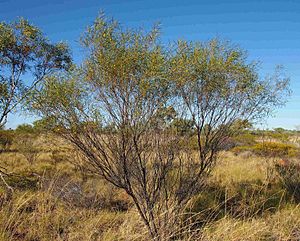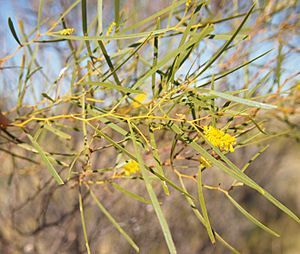Fitzroy wattle facts for kids
Quick facts for kids Fitzroy wattle |
|
|---|---|
 |
|
| Acacia ancistrocarpa habit | |
| Scientific classification | |
| Genus: |
Acacia
|
| Species: |
ancistrocarpa
|
 |
|
| Occurrence data from AVH | |
The Fitzroy wattle (scientific name: Acacia ancistrocarpa) is a type of shrub. It's also known by other names like fish hook wattle, pindan wattle, and shiny leaved wattle. This plant belongs to the large Acacia family.
Contents
About the Fitzroy Wattle
The Fitzroy wattle is a shrub that can grow from about 0.6 metres (2 ft) (2 feet) to 3 metres (10 ft) (10 feet) tall. It has many stems and spreads out as it grows.
Flowers and Leaves
This wattle produces bright yellow flowers. You can usually see them blooming from March to August. The flowers grow in spikes that are about 1.5 cm (0.6 in) to 4 cm (1.6 in) long.
Its leaves are a shiny olive-green color. They are long and narrow, like a blade. These leaf-like parts, called phyllodes, can be 5 centimetres (2 in) to 18 centimetres (7 in) long and 2.5 millimetres (0.098 in) to 13 millimetres (0.512 in) wide.
Seed Pods
After the flowers, the plant forms seed pods. These pods are narrow and slightly curved. They can be 5 cm (2.0 in) to 11 cm (4.3 in) long and 7 mm (0.28 in) to 15 mm (0.59 in) wide. The name "ancistrocarpa" comes from Greek words meaning "fish-hook fruit," which describes the hooked tip of these pods.
Where It Lives
The Fitzroy wattle is found in parts of Australia. It grows naturally in the Northern Territory, and in the Pilbara and Kimberley regions of Western Australia. You can also find it in far western Queensland.
Habitat
This plant likes to grow in sandy soils that are often red and acidic. It's commonly found on plains, along creeks, or in areas with spinifex grasses.
Growth Habits
While it doesn't usually form thick forests, the Fitzroy wattle can grow back easily after a bushfire or when the ground is disturbed. This helps it create new populations in its habitat.
Naming the Plant
The Fitzroy wattle was first officially described by two botanists, Joseph Maiden and William Blakely. They wrote about it in 1928.
Hybrids
Sometimes, the Fitzroy wattle can mix with other wattle species. For example, it is known to form natural hybrids with another plant called Acacia trachycarpa.



